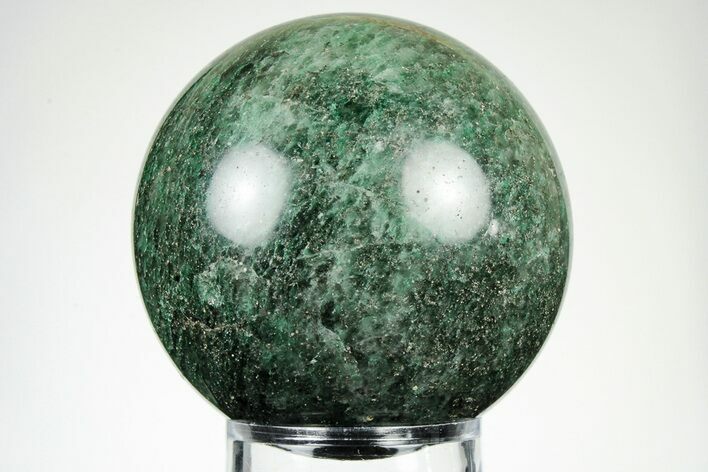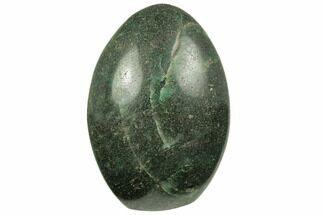This Specimen has been sold.
3" Polished Fuchsite Sphere - Madagascar
This is a 3" wide sphere formed from fuchsite chert. It has been polished to a mirror-like finish and was collected and sculpted in Madagascar. The blue-green coloration is wonderful and the flakes of pyrite and muscovite give the sphere a unique sparkle.
Comes with the pictured display stand.
Comes with the pictured display stand.
About Fuchsite Chert
Fuchsite chert, also commonly referred to as "Dragon Stone", is cryptocrystalline quartz stone metamorphosed from fuchsite. It forms when a fuchsite vein is subjected to intense pressure and dissolution from super hot ground waters, which partially dissolve the fuchsite into a silica solution, forming large boulders. Much of the material retains fuchsite's emerald green coloring, but can also be found in lighter shades of green. Fuchsite, also known as chrome mica, is a chromium-rich variety of the mineral muscovite.
Fuchsite chert, also commonly referred to as "Dragon Stone", is cryptocrystalline quartz stone metamorphosed from fuchsite. It forms when a fuchsite vein is subjected to intense pressure and dissolution from super hot ground waters, which partially dissolve the fuchsite into a silica solution, forming large boulders. Much of the material retains fuchsite's emerald green coloring, but can also be found in lighter shades of green. Fuchsite, also known as chrome mica, is a chromium-rich variety of the mineral muscovite.
About Quartz
Quartz is the name given to silicon dioxide (SiO2) and is the second most abundant mineral in the Earth's crust. Quartz crystals generally grow in silica-rich environments--usually igneous rocks or hydrothermal environments like geothermal waters--at temperatures between 100°C and 450°C, and usually under very high pressure. In either case, crystals will precipitate as temperatures cool, just as ice gradually forms when water freezes. Quartz veins are formed when open fissures are filled with hot water during the closing stages of mountain formation: these veins can be hundreds of millions of years old.
Quartz is the name given to silicon dioxide (SiO2) and is the second most abundant mineral in the Earth's crust. Quartz crystals generally grow in silica-rich environments--usually igneous rocks or hydrothermal environments like geothermal waters--at temperatures between 100°C and 450°C, and usually under very high pressure. In either case, crystals will precipitate as temperatures cool, just as ice gradually forms when water freezes. Quartz veins are formed when open fissures are filled with hot water during the closing stages of mountain formation: these veins can be hundreds of millions of years old.
SPECIES
Muscovite var. Fuchsite, Pyrite & Quartz
LOCATION
Madagascar
SIZE
3" wide
CATEGORY
ITEM
#196306
 Reviews
Reviews













